Church of St. Martin in the Wall
| Church of St. Martin in the Wall | |
|---|---|
| kostel svatého Martina ve zdi | |
 | |
| Location | Prague |
| Country | Czech Republic |
| Denomination | Evangelical Church of Czech Brethren |
| Website | Website of Church |

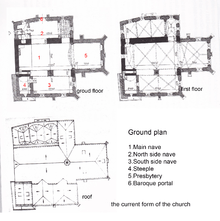
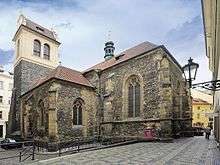
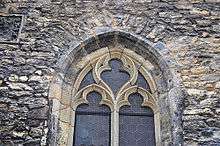
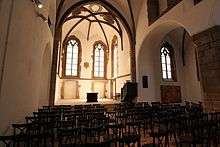
The Gothic church with Romanesque ground is situated in the Old Town in Prague. It was built between 1178-1187 in the former village Újezd, which was then called Újezd u svatého Martina. The construction of the church south wall was adjacent to the walls of the Old Town hence the full name of the church contains "in the wall". This church belongs to the Evangelical Church of Czech Brethren.
Construction
Romanesque structure
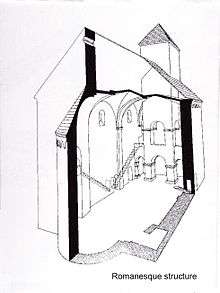
The settlement, in which the church was built, was called “Újezd” before 1178 and “Újezd sv. Martina” after 1187. So it is considered that the church was built between those years, when the settlement was a duque's property. The settlement was a gift to Vyšehrad chapterby duque Soběslav II. During the construction of the Old Town walls in the 1230s, Újezd was divided into two parts, the bigger part remained in the later New Town and the smaller part with the church became a part of the Old Town. The south side was connected to the wall, for this reason got the church the attribute "in the wall". There was also the town gate of St. Martin in the neighbourhood.
St. Martin's Church became the object of the scientific researches especially after finding its Romanesque base during the renovation carried out by Kamil Hilbert in the early 20th century. In 1905 a comprehensive study by J. Teige was published. Huge attempts were made about reconstruction its original form. Scientists (their fields of research are described separately) Birnbaum and Čarek thought about two towers in the eastern side, Mencl supposed rather a pair of inner galleries in the southeast and northeast corner with the access through two staircases in the thickness of the wall and a single steeple in the western part of the nave. This theory was widely accepted.
Líbal rejected the idea about the west steeple, he pointed out the too weak pillars of he inner gallery. Dragoun uncovered brickwork of southeast side area. Ground plan of the eastern part of the church was very irregular. This form of early medieval church differed significantly from the production of that period.
The original foundation of the church with one nave was virtually identical to today's main nave with today's shape and a number of Romanesque architectural elements. The interior of the Romanesque church was probably decorated with murals. The church was vaulted with two fields of cross vaults.
Gothic reconstruction
Gothic building modifications were made during the reign of Charles IV after 1350. The shrine was founded in 1358. The floor level was heightened. The nave was extended with a new presbytery, which has a pair of windows in the front wall. It was vaulted with the special kind of net vault, called jump vault. Its ribs end on brackets and the whole space was roofed with hip roof. The south wall was breached with new pointed windows (however, their present shape is the result of Hilbert´s renovation).
The nave was heightened and newly vaulted. A prismatic wall was built in the southwest corner. The vault with irregular shape and a steeple on the side of the church were completed before 1358. The presbytery was vaulted with the rib vault in the 1360s, which is considered one of the oldest of that kind vaulting in the country. Its ribs grow from pyramidal consoles with mascarons, on the apex stones (connecting parts) there are roses and a star. A ledge under window runs around the gallery. The removal of the walls of the town fortification next to the church was a necessary condition for the extension of the building to the east.
St. Martin's parish priest Jan of Hradec, a supporter of Jan Hus began to distribute Communion in the church in the Protestantway - under both kinds - one of the first in Bohemia in 1414. In 1433 a Hussite Assembly was held in the church of St. Martin's. Because it was the utraquist church, it was not destroyed during the Hussite wars.
The church gained its current ground plan during the late Gothic adaptations. The rebuilding was completed in 1488, thanks to funding by citizen Viktorin Holas. He established a bridge from his house to the tribune of the church. During this period were built also side naves – the northern with three bays and southern part with two bays of cross ribbed vaults. The church gained today´s ground plan. The portal of the main nave to the gallery in the northern nave is also late Gothic.
In 1595 a collection was started to repair the church, which was carried out in 1600. Then were constructed new roof and cemetery fence and also the ossuary was built, then the church was plastered and painted by master Jan Kohoutek. Painter Jakub Slánský completed the painting above the pulpit and Petr Smolik wrote the text of the Compacts of Basel on the walls. In 1611, the chapel of St. Roch was founded on the south side. In 1678 a fire destroyed the district of St. Martin. Also the upper part of the steeple was rebuilt after fire. In the lower part it was provided with a scarp. The church got a new roof, the chapel of St. Eligius gained still preserved beamed ceiling under the oratory.
Baroque modifications
A Baroque portal was built on the north side (facing the street) In 1779. Eventually the arcades between the naves were plastered. Soon afterwards, in 1784 the church was cancelled by an imperial patent by Joseph II, Holy Roman Emperor and sold with the device at auction on August 29, 1785. It became a residential house, it was divided into two floors, the lower contained shops (and in this way the church was depicted in Langweil model of Prague).
Reconstruction in the 20th century
In 1904 the church was bought by the City of Prague and in 1905 Kamil Hilbert began to reconstruct the church. During the reconstruction they removed the chapel on the south side of the tower and modified the tower roofing. In 1909, a memorial board of family Brokof by Joseph Mařatka was placed on the north wall of the presbytery. After the First World War, the church was assigned to Evangelical Church of Czech Brethren, which conducted the general repair.
The building currently

Ground plan The church has pseudo-basilical plan with three naves. It has a square chancel and tower in the southwest corner. The Ground is quite irregular. It is caused by frequent alterations.
Main nave
The nave is covered with a gabled roof, over the presbytery with hipped roof, over the facade shield with a keel. The rectangular nave is vaulted with two almost square fields of the cross vault with an inter-vault rib. The centre console in the north wall is replaced with a semi-cylindrical console underneath which there is a flat pilaster. The western field is in the width of the choir organ is bent with a pointed vault with a belt. On the vault there is coat of arms with the Czech lion. The north wall of the main nave with triumphal arch at high pointed arch opens into the adjoining chapel of St. Eligius. Two semicircular heads of the former Romanesque vault were uncovered by Hilbert on the wall of the main nave, in the eastern head a rectangular hole. The original saddle portal with the intersection leads from the north side of the organ-loft. The south wall of the main nave is broken into the side nave with two semicircular arcades on massive square bevelled block-style pillars. The organ-loft (choir) is vaulted with one field of cross-comb vaults. The railing is fully walled, strengthened with pentagonal pillars. Under the organ-loft there was discovered the lower choir. Romanesque floor level runs here about 2 feet below.
North side nave
Over the northern side nave there are three hipped roofs. North side nave has a uniaxial western wall, the ground floor has a neo-Gothic portal with Kamil Hilbert´s initials and dated 1906.The side northern facade is without buttresses and has four axial symmetry. Gothic portal with profiled lining by Hilbert adds aedicule framing oval cartouche in the shield, it comes from the Baroque portal from the late 17th century. The cartridge is decorated with baroque painting of St. Martin on horseback. North side nave includes the oratory with star vault in the eastern part of the floor of, completed with a circular bolt with a knight label. The corner consoles are in the shape of masks. The Chapel of St. Eligius under the oratory has got a Baroque decking painted ceiling with ornamental, figural and animal motifs. The rest of the side nave is topped in a cross way with inter-vault ribs are also circular bolts. Next to the wall of the north side nave there is the Renaissance tombstone of Milota of Dražice.
South side nave
The southern wing has two fields of cross vault, which is separated with a passport. Cuneiform one-trough ribs intersect circular bolts. The bractets are pyramid-shaped. They are decorated in a naturalistic way (vegetable leaves). On the west wall at the steeple there is a pointed Gothic portal below the level of the present floor, which is compared to the Gothic heightened by about 65 cm. Furthermore, the neo-Gothic entrance to the staircase to the steeple. It is built mainly of quarried stone. It has a ground floor and barrel vault. A Romanesque staircase in the thickness of the wall leads upstairs.
The south side nave has a sideways built abutment on the corner and two others on the south wall. Two broken windows with restored tracery lead into the nave on the eastern side and one on the eastern side. On the right by the upper part of the eastern abutment there is a rectangular plate inserted with a relief of a helmet with wings and fafrnochs (Czech folk drums). The steeple is connected to the side wall of the nave. A sideways brick walled scarpa strengthens the corner. The north and south side of the steeple is breached with a big baroque semicircular window. The steeple is ended up with renaissance triangular gables.
Presbytery
The presbytery has square ground plan. It is rectangular and ended up on the corners fitted with sideways ranking posts. On the south side it is decorated with a stone owl, the northern with human figures in the shape of gargoyles. The presbytery is arched with a net vaulting. The ribs have subtle pear profile. On the vault there are coat of arms painted by J. Kohoutek.
Attractions
Legend about a petrified boy
A legend is told about the gargoyles in the form of a little boy at the church. According to the legend a house stood near the church, where a widow moved. Her financial situation began to worsen after some time, so he worked as a maid. While she was at work, her son made troubles. Once, when she returned from work, she saw a crowd of people staring up at the roof of the church. She saw her naughty son running on the sacred building. That made her very upset so she shouted:, You villain, become a stone for this sin!” As he said that, her curse became truth. The boy didn´t even have time to straighten up and turned into a stone with his tongue stuck out.
Persons in the article
Soběslav II
(1128-1180) – a Bohemian Duke; nickname: Prince of the Peasants; he granted a charter to the town of Prague
Jan Hus
English form John Huss (1369-1415) – a Czech catholic priest, scholar, philosopher, early reformer and professor at Charles University of Prague; executed; a predecessor of Protestantism; considered as a martyr saint
Brokoff family
(16th and 17th century) – stonemasons, carvers and sculptors, came from Upper Hungary, present-day Slovakia; e.g. Johann Brokoff (1652 – 1718) made some of the statues on the Charles Bridge in Prague
Langweil´s model of Prague
– a paper model of historical centre of Prague built on the area of about 20 square metres by an employee of the university library, Antonin Langweil. The scale is 1:480. There are more than 2000 buildings. About half of them no longer exist. There are Lesser Town, Old Town and Prague Castle. The model is made of cardboard, using some wooden elements.
Kamil Hilbert
(1869 – 1933) a Czech architect, conservator; he finished the building of St. Vitus Cathedral
Mařatka Josef
(1874–1937) – a Czech sculptor
Birnbaum Vojtěch
–(1877–1934) a Czech historian of art
Čarek Jiří
PhD. (1908–1985) – an archivist, heraldry, historian Prague.
Líbal Dobroslav
(1911–2002) a Czech historian of architecture and urbanism.
Dragoun Zdeněk
(*1946) an archeologist, from his work: Rescue excavations in the church of St. Martin in the Wall in the Old Town; Romanesque Houses in Prague
References
Translated from the Czech page: Kostel svatého Martina ve zdi
- Pijte z něho všichni: kostel u sv. Martina ve zdi a víra v něm. Příprava vydání Mikuláš Vymětal. 1. vyd. Benešov : Eman, 2014. 303 s. ISBN 978-80-86211-99-2.
- TEIGE, Josef. Kostel sv. Martina Většího ve zdi na Starém Městě Pražském. Praha : Královské hlavní město, 1905. Dostupné online.
- KOŠNÁŘ, Julius. Staropražské pověsti a legendy. Praha : Vincentinum, 1933. Dostupné online. - kapitola Zkamenělý hoch na střeše kostela sv. Martina ve zdi, s. 96-97.* VLČEK, Pavel. Umělecké památky Prahy- Staré Město, Josefov. Praha : Academia, 1996. * LÍBAL, Dobroslav. Staré město pražské- architektonický, urbanistický vývoj. Praha : Lidové noviny, 1996.
- MERHAUTOVÁ, Anežka. Raně středověká architektura v Čechách. Praha : Academia, 1971.
- ČAREK, Jiří. Kostel svatého Martina ve zdi. Praha : Výtvarný odbor Umělecké besedy, 1940.
- KALINA, Pavel. Praha 1310-1419. Kapitoly o vrcholné gotice. Praha : Libri, 2004.
- VARHANÍK, SOMMER. Stavební vývoj kostela sv. Martina ve zdi na Starém Městě pražském do doby předhusitské. Praha : Archaelogica Pragensia, 1984.
- MIKESKA, Pavel. Kostel sv. Martina Většího ve zdi na Starém Městě pražském. Praha, 2013 - Bakalářská práce UDKU KTF UK.
External links
- Street view
- Photos
- Church of St. Martin in the Wall
- Church of St. Martin in the Wall
- Church of St. Martin in the Wall
- Church of St. Martin in the Wall
- Churches in Prague
Coordinates: 50°04′59″N 14°25′12″E / 50.0831°N 14.4200°E